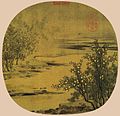File:Yellow Oranges and Green Tangerines (橙黃橘綠) by Zhao Lingrang (趙令穰).jpg

Cabirka muuqaalkaan: 621 × 599 pixels. Waxyaabaha kale xalinta: 249 × 240 pixels | 498 × 480 pixels | 792 × 764 pixels.
Faylka asalka ah (792 × 764 pixels, weyninka faylka : 277 KB, nuuca MIME: image/jpeg)
Taariikhda faylka
Riix taariikhda/waqtiga si aad u argto faylka sida oo ahaa markiisa hore.
| Taariikhda/Waqtiga | Sawir yar | Cabirka | Isticmaale | Ka hadalka | |
|---|---|---|---|---|---|
| kan hadda | 22:23, 4 Nofeembar 2014 |  | 792 × 764 (277 KB) | MuseumGeek | =={{int:filedesc}}== {{Artwork |artist = {{en|Zhao Lingrang}} {{zh|趙令穰}} |title = {{en|Yellow Oranges and Green Tangerines}} {{zh|橙黃橘綠}} |description = {{en|1=Chi... |
Faylka lagu isticmaalay
waxyaabaha soo socda ee 5 boggag ayaa isticmaalaya faylkaan:
isticmaalka faylka aduunka
Wikisyada kale ee soosocda ayaa adeegsanaya faylka:
- Ku isticmaal de.wikipedia.org
- Ku isticmaal en.wikipedia.org
- Ku isticmaal fr.wikipedia.org
- Ku isticmaal ja.wikipedia.org
- Ku isticmaal pt.wikipedia.org
- Ku isticmaal zh-classical.wikipedia.org
- Ku isticmaal zh.wikipedia.org



